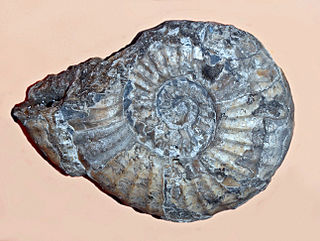Ussuria is a genus of Lower Triassic ammonites with a smooth, involute discoidal shell with submonophyllic sutures, belonging to the ceratitid family Ussuriidae.

Aturia is an extinct genus of Paleocene to Miocene nautilids within Aturiidae, a monotypic family, established by Campman in 1857 for Aturia Bronn, 1838, and is included in the superfamily Nautilaceae in Kümmel 1964.

Psiloceratoidea is a superfamily of Early Jurassic ammonoid cephalopods proposed by Hyatt in 1867, assigned to the order Ammonitida. They were very successful during Hettangian and Sinemurian. Last of them, family Cymbitidae and genera Hypoxynoticeras and Radstockiceras survived into Early Pliensbachian.
Permoceras, the sole member of the family Permoceratidae, is a genus of coiled nautiloids with a smooth, compressed involute shell, whorls higher than wide, earlier whorls hidden from view. The venter is rounded as are the ventral and umbilical shoulders, the flanks flattened. The siphuncle is ventrally subcentral. The suture, which is most characteristic, has a deep, narrow pointed ventral lobe and large, asymmetrical pointed lobes on either side.
Heminautilus is an extinct genus of nautiloids from the nautilacean family Cenoceratidae that lived during the Early Cretaceous. Fossils of Heminautilus have been registered in rocks of Barremian and Aptian age. Nautiloids are a subclass of shelled cephalopods that were once diverse and numerous but are now represented by only a handful of species.
The Clydonautiloidea are a superfamily within the nautiloid order Nautilida characterized by smooth, generally globular, shells with nearly straight sutures, in early forms, but developing highly differentiated sutures in some later forms. Where known, the siphuncle tends to be central to subcentral.

The Trigonoceratoidea are a superfamily within the Nautilida that ranged from the Devonian to the Triassic, thought to have contained the source for the Nautilaceae in which Nautilus is found.
Syringonautilidae is a family of Nautiloidea from the middle to late Triassic. Syringonautilidae comprise the last of the Trigonoceratoidea and are the source for the Nautilaceae which continued the Nautiloidea through the Mesozoic and into the Cenozoic right down to the recent. Syringonautilidae is a strictly Triassic family, derived early in the Triassic from the Grypoceratidae.

Grypoceratidae is the longest-lived family of the Trigonoceratoidea, or of the near equivalent Centroceratina; members of the Nautilida from the Upper Paleozoic and Triassic.
The Centroceratidae is the ancestral family of the Trigonoceratoidea and of the equivalent Centroceratina; extinct shelled cephalopods belonging to the order Nautilida
Aphelaeceras is an extinct genus from the nautilid family Trigonoceratidae which is part of the Trigonocerataceae, that lived during the Mississippian Period in the late Paleozoic.
Condraoceras is a genus of liroceratids from the Pennsylvanian of North America and Lower Permian of Europe with a compressed, involute, nautiliconic shell; subcircular whorl section; small umbilicus with a rounded shoulder; suture with shallow ventral and lateral lobes; and narrow subcentral siphuncle.
Thuringionautilus is a genus of large, moderately involute, nautiloids from the nautilid family Tainoceratidae. The whorl section is subquadrate, flanks slightly convex, venter broad with a median furrow. Ventral shoulders, narrowly rounded to subangular; umbilical shoulders, broadly rounded. Longitudinal nodes slope diagonally backwards on the venter toward the furrow. Suture, slightly sinuous. Siphuncle, subdorsal.
The Rhiphaeoceratidae are a small family of nautilids included in the superfamily Tainoceratoidea that comprises four very similar genera. These genera are characterized by a perforate umbilicus and little more than a single evolute coil. Whorl sections are oval, subquadrate, or subtrapezoidal. Sutures bend forward on the outer rim, forming wide shallow ventral saddles and dip strongly to the rear on the inner rim, forming deep dorsal lobes.
Subvestinautilus is a genus of evolute koninckioceratids, in the order Nautilida, with a depressed, trapezoidal whorl section. The venter is broadly rounded, ventrolateral shoulders sharply rounded, flanks flattened and converging toward a narrow rounded dorsum. In early growth stages a keel forms on the umbilical shoulder which becomes rounded or marked by a longitudinal rib at maturity. The suture has a broadly rounded ventral lobe and a deeper lateral lobe.
Pseudonautilidae is a family of Jurassic and Lower Cretaceous nautilid cephalopods belonging to the same superfamily as modern Nautilus, Nautilaceae, but forming a different branch from the family Nautilidae. Pseudonautilids, together with other nautilids, were contemporary with the ammonoids, which comprise an entirely different set of shelled cephalopod stocks more closely related to octopus and squid.
Carinonautilus is a genus of extinct, Middle Cretaceous nautilid with a very involute, compressed shell in which the whorl section is higher than wide, umbilicus is small and shallow, or flanks converge on a narrow venter that has a rounded keel. A furrow on either side marks the ventro-lateral shoulder.
Indonautilus is an involute nautilid from the Middle and Upper Triassic. (Anisian-Norian), with a small or occluded umbilicus and subrectangular whorl section belonging to the Liroceratidae (Clydonaulilaceae). Flanks are slightly bowed, converging on a flattened venter. Ventro-lateral shoulders are narrowly rounded or angular. Umbilical shoulder are broadly rounded. The siphuncle is subdorsal.

Domatoceras is a nautiloid genus and member of the Grypoceratidae from the Pennsylvanian and Permian with a wide spread distribution.
Ochetoceras is a genus of ammonites, belonging to the Oppeliidae, that lived during the Late Jurassic from the early Oxfordian to the early Tithonian, and type for the subfamily Ochetoceratinae.



